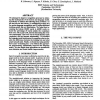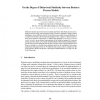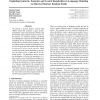770 search results - page 7 / 154 » Subsequence similarity language models |
NAACL
1994
13 years 9 months ago
1994
We attemped to improve recognition accuracy by reducing the inadequacies of the lexicon and language model. Specifically we address the following three problems: (1) the best size...
EPK
2007
13 years 10 months ago
2007
Abstract: Quality aspects become increasingly important while business process modeling is used in a large-scale enterprise setting. In order to facilitate a storage without redund...
CAISE
2008
Springer
13 years 10 months ago
2008
Springer
Quality aspects become increasingly important when business process modeling is used in a large-scale enterprise setting. In order to facilitate a storage without redundancy and an...
BMCBI
2007
13 years 8 months ago
2007
Background: The rapid burgeoning of available protein data makes the use of clustering within families of proteins increasingly important. The challenge is to identify subfamilies...
ICML
2005
IEEE
14 years 9 months ago
2005
IEEE
We present a directed Markov random field (MRF) model that combines n-gram models, probabilistic context free grammars (PCFGs) and probabilistic latent semantic analysis (PLSA) fo...



